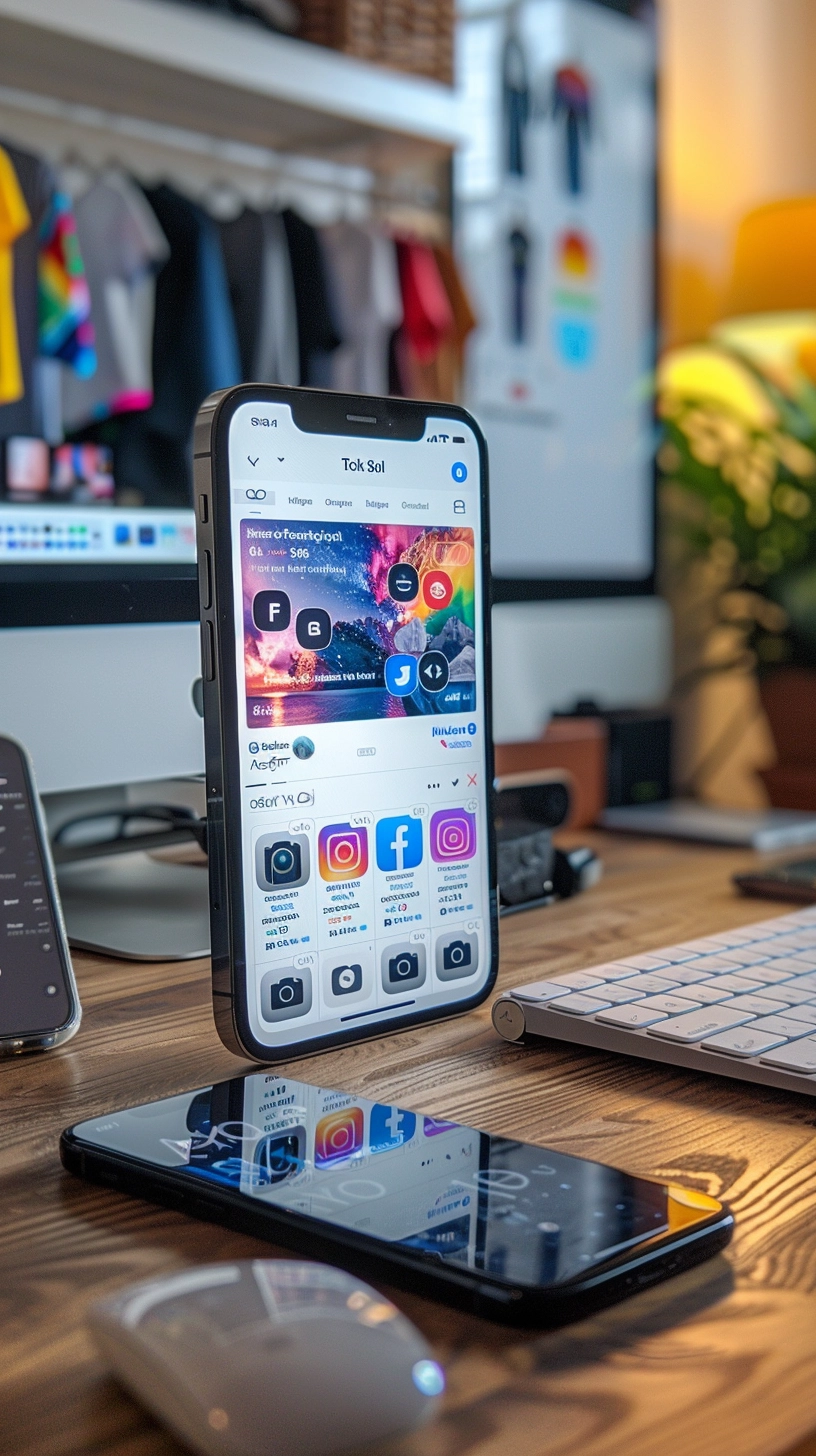Introduction to Micro-Moments in Digital Branding
Micro-moments have become a crucial foundation for businesses aiming to engage with their audience in the digital age when online interactions are fundamental to consumer behavior. These short, purposeful instances when a user uses a gadget to fulfill a specific need are crucial chances for businesses to influence choices and preferences.

Definition and Significance
Micro-moments occur when an individual instinctively uses a gadget, often a smartphone, to address an urgent requirement. The needs may be classified into four specific types: informational, navigational, transactional, and commercial. During these times, high expectations and poor patience emphasize the importance of a brand’s reaction being fast, relevant, and convenient.
The significance of micro-moments in digital branding is crucial. Due to the widespread use of cell phones and the internet, customers’ buying processes are now scattered over several online and physical platforms, rather than following a straight path. Micro-moments provide companies with a way to comprehend and address consumer requirements instantly, leading to stronger connections and more significant interactions.
Consumer Behavior Evolution
The digital era has brought about a significant change in consumer behavior. Consumers today have access to vast amounts of information and can expect immediate satisfaction. This change has divided the customer experience into a sequence of micro-moments, providing companies with chances to impact decision-making. In contrast to traditional marketing, the digital environment necessitates businesses to be adaptable, reactive, and engaged during critical times for their audience, which are less predictable and controllable.
Investigate the role of customer feedback in branding:

Categories of Micro-Moments
- I-want-to-know moments: When a person is in the research phase but not actively looking to make a purchase. They seek valuable information, advice, or motivation.
- I-want-to-go moments: These happen when a user is seeking a local company or contemplating purchasing a product from a nearby retailer.
- I-want-to-do moments: This includes instances where a user requires assistance in finishing a job or attempting something unfamiliar. It frequently entails looking for instructional videos or written guides.
- I-want-to-buy moments: These moments occur when a user is prepared to buy but may want assistance in determining what or how to acquire.
Brands that comprehend and enhance these micro-moments may strategically position themselves in the consumer’s journey at the most opportune moment. A brand that provides succinct, useful material that is readily available during a consumer’s time of seeking information not only meets the immediate demand but also establishes itself as a reliable and supportive source.

The incorporation of micro-moments into the digital branding vocabulary has given businesses a fresh perspective on how to perceive and engage with the consumer’s journey. Identifying and reacting to these instances with appropriate, prompt, and valuable material may greatly improve a brand’s interaction and allegiance.
Strategies for Leveraging Micro-Moments
Today, grasping and utilizing micro-moments is essential for successful digital branding in the current digital environment. Let’s have insight into the techniques that businesses may use to take advantage of brief chances, transforming possible interactions into significant engagements that enhance brand loyalty and increase conversions.
Comprehending Customer Intent
Understanding client intent is essential for effectively utilizing micro-moments. Intent-driven marketing involves detecting consumers’ current requirements and customizing content and answers to match those needs. When a person looks for “best coffee near me,” it indicates that they are specifically seeking coffee choices in their nearby location. Brands such as Starbucks have succeeded in seizing micro-moments by ensuring their local outlets are prominently shown in search results, along with details on facilities, operating hours, and mobile ordering options.

Data analytics is essential for identifying trends in customer behavior, allowing companies to predict requirements and offer solutions proactively, even before they are expressly stated by the user. Tools like Google Analytics, social media insights, and customer relationship management (CRM) systems offer abundant data that, when evaluated correctly, may uncover specific consumer intentions at different points in their journey.
Content and Communication
Brands must ensure that the material and message they use in reaction to micro-moments is brief, pertinent, and engaging. Due to the brevity of these contacts, there is a limited opportunity to catch attention and communicate value. Creating a diverse range of materials customized for various micro-moments is key to a successful approach. For instance, instructional videos or blog entries can target “I-want-to-do” situations, whereas product comparison sites or reviews might focus on “I-want-to-buy” situations.
Customization improves the effectiveness of material during brief times. Brands may personalize their messaging by using data from previous interactions, interests, and locations to better connect with specific individuals. Amazon’s “customers who bought this item also bought” suggestions exemplify the use of customization to leverage micro-moments, directing consumers towards subsequent purchases aligned with their present buying intent.
Unveil the creation of a cohesive brand experiences:
Mobile Optimization
Given that most micro-moments happen on mobile devices, mobile optimization is not just advantageous but essential. Creating a mobile-responsive website or app is essential for providing fast loading speeds, simple navigation, and a smooth user experience. Google’s Mobile-Friendly Test and PageSpeed Insights are useful resources for evaluating and enhancing the performance of mobile websites.

In Addition to technological optimization, businesses must also take into account the mobile user’s context. Implementing features like click-to-call buttons, location-based services, and streamlined payment procedures may greatly improve the mobile user experience during brief periods of interaction. Domino’s Pizza allows consumers to easily order using their app, taking advantage of “I-want-to-eat” situations by streamlining the process.
Dive into the principles of adapting to new design styles:
Implementing Efficient Tactics
Effectively utilizing micro-moments depends on a brand’s capacity to predict demands, involve customers with pertinent information, and offer a smooth mobile experience. Brands may capitalize on micro-moments by prioritizing consumer intent, creating tailored messages, and optimizing for mobile devices to enhance engagement and increase conversion rates.
Examples of Brands Achieving Success via Micro-Moments
In the ever-changing realm of digital marketing, recognizing and taking advantage of micro-moments has become an essential tactic for firms looking to attract consumers’ attention precisely when needed.

Spotify: Customizing the “I-want-to-listen” Moment
Spotify has effectively taken use of the “I-want-to-listen” micro-moment by using big data to provide tailored music suggestions. Spotify uses data on users’ listening patterns, time of day, and weather to generate personalized playlists like “Discover Weekly” and “Daily Mix” that match the user’s mood or current activities. Hyper-personalization guarantees continuous user engagement by seizing every moment of possible interest in new music or podcasts to provide precisely what the listener seeks on Spotify.
Wayfair: Elevating the “I-want-to-decorate” Moment
Wayfair, a prominent online retailer specializing in home products, capitalizes on the “I-want-to-decorate” micro-moment by utilizing advanced augmented reality (AR) technology. Wayfair’s mobile app enables buyers to see furniture and décor in their homes before buying. This augmented reality tool alleviates the typical uncertainty associated with purchasing furniture online by helping users visualize how items will fit and appear in their area. This ultimately improves the decision-making process and enhances the user experience during key moments when they are considering decorating or renovating.

Sephora: Capturing the “I-want-to-try” Moment
Sephora, a prominent beauty retailer, effectively seizes the “I-want-to-try” micro-moment with its Virtual Artist app feature. This tool utilizes face recognition technology to enable customers to virtually test various cosmetic items. This application engagingly engages users and decreases confusion linked to buying beauty goods online. Sephora bridges online browsing and in-store experiences by catering to the urgent need to experiment with different looks, therefore promoting exploration and purchase.
Zillow: Enhancing the “I-want-to-move” Moment
Zillow capitalizes on the “I-want-to-move” micro-moment by offering mobile features that allow users to browse real estate listings with full information, virtual tours, and tailored notifications. Zillow establishes itself as an essential resource by providing customers with convenient access to possible new houses at any time and place, simplifying the often daunting process of purchasing or renting a new home. This smooth incorporation into the user’s experience takes advantage of sudden moments of curiosity, enhancing involvement and decision-making.
Duolingo: Capturing the “I-want-to-learn” Moment
Duolingo, the language learning platform, succeeds by capturing users’ attention at the “I-want-to-learn” micro-moment. Duolingo is a gamified method for language learning, providing brief, easily digestible lessons that users may engage with during idle moments, transforming brief instances of interest into chances for learning. The app’s customized reminders and tracking of progress increase involvement, seamlessly integrating the learning of a new language into the user’s routine.

Success Factors Analysis
The examples show that effectively utilizing micro-moments depends on grasping the user’s context and purpose and providing an experience that is not only relevant but also compelling to prompt action. Spotify and Wayfair have successfully integrated themselves into consumers’ everyday routines through creative methods like tailored playlists and AR-powered buying.
The shared success characteristics among these cases are:
- Personalization: Adapting experiences to the interests and situation of the individual.
- Convenience: Removing obstacles to action and facilitating the user’s transition from intention to choice as much as feasible.
- Engagement: The process of developing engaging, interactive experiences that draw in customers and motivate them to contact a business longer.
- Innovation: The use of technology in previously impractical ways to improve the consumer experience.
Brands may succeed in capturing micro-moments and developing lasting relationships with customers by concentrating on these qualities, turning brief interactions into everlasting loyalty.
Uncover strategies for building brand loyalty:

Micro-Moments’ Future and Challenges in Digital Branding
Brands must carefully negotiate several hurdles as they increasingly concentrate on capturing and profiting from micro-moments. But there are also great chances for innovation and increased customer interaction in this changing environment. This section examines the challenges, upcoming trends, and tactical suggestions for companies aiming to succeed in the micro-moment space.
Challengers in Making Use of Micro-Moments
- Data Privacy and Trust: Brands need to exercise caution in how they gather, utilize, and retain personal data in light of consumers’ increased knowledge of and concerns about data privacy. It takes skill to strike a balance between customizing experiences and fostering trust.
- Technological Restrictions: It takes constant investment in skills and technology to stay ahead in the fast-paced digital sector. This may be a serious obstacle for a lot of companies, particularly smaller ones.
- Real-Time Engagement: Because consumers now expect quick satisfaction, companies need to be able to interact with them in real time. This calls for strategic planning and vision in addition to technology infrastructure.
- Content Saturation: It’s getting harder to stand out and draw attention in little times when customers are inundated with information.

Future Trends in Micro-Moments
- Artificial Intelligence and Machine Learning: With previously unheard-of levels of customization and efficiency, AI and machine learning are poised to completely transform how companies anticipate, analyze, and react to micro-moments.
- Virtual reality (VR) and Augmented Reality (AR): As these technologies become more widely available, they will present new opportunities for marketers to develop engaging, interactive experiences that draw in customers in brief bursts.
- Voice Search and Assistants: As voice search and digital assistants such as Alexa, Siri, and Google Assistant become more commonplace, there is a need to change the way information is displayed and optimized for companies to be present in these conversational micro-moments.
- Internet of Things (IoT): With the use of real-time data, IoT devices will allow marketers to seamlessly integrate digital and physical experiences, engaging customers in micro-moments across a range of settings and devices.

Strategic Recommendations for Brands
- Put Transparency and Privacy first: To foster loyalty and trust, make it clear how customer data is utilized and give them control over their data. Transparency is an important factor for brand differentiation.
Learn other secrets of brand differentiation:
- Invest in Real-Time Analytics: Brands may better comprehend and respond to micro-moments as they happen by utilizing real-time data analytics.
- Produce Contextually Relevant Content: Provide material that is both pertinent and customized to the environment in which the user is most likely to encounter a micro-moment.
- Optimize for Mobile and Voice Search: As mobile devices account for the majority of micro-moments, it is imperative to provide a flawless mobile experience. Furthermore, voice search optimization may assist firms in remaining current with changing search trends.
- Experiment with Emerging Technologies: To stay ahead of the curve and develop innovative customer experiences, explore and experiment with AR, VR, AI, and IoT.

The capacity of micro-moments to engage customers at the exact moment of intent and provide personalized, captivating experiences that motivate action is what gives them such strength in digital branding. Although there are many obstacles to overcome, there are also many chances for creativity and stronger customer connections. Through a strategic approach to technology, privacy, and customization, companies can leverage the power of micro-moments to do amazing things in the digital age.
Future-focused businesses will be those who stay ahead of the curve in terms of landscape adaptation, foresee customer demands, and innovate ceaselessly to satisfy those wants throughout the entire digital journey.



